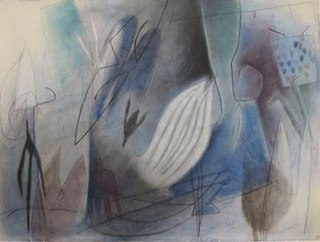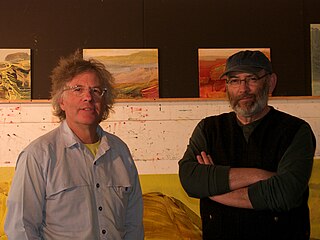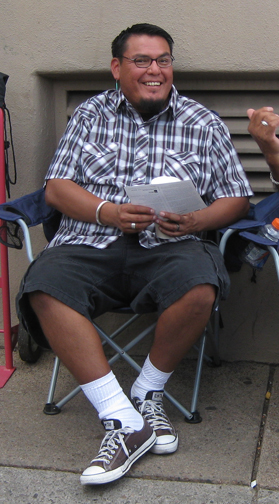
The Eiteljorg Museum of American Indians and Western Art is an art museum in downtown Indianapolis, Indiana, United States. The Eiteljorg houses an extensive collection of visual arts by indigenous peoples of the Americas as well as Western American paintings and sculptures collected by businessman and philanthropist Harrison Eiteljorg (1903–1997). The museum houses one of the finest collections of Native contemporary art in the world.

Emmi Whitehorse is a Native American painter and printmaker. She was born in Crownpoint, New Mexico and is a member of the Navajo Nation. She lives in Santa Fe, New Mexico and grew up on the open land northeast of Gallup, New Mexico in a family where only the Navajo Language was spoken.
Mario Martinez is a Native American contemporary abstract painter. He is a member of the Pascua Yaqui Tribe from New Penjamo, the smallest of six Yaqui settlements, in Arizona. He currently lives in New York City.

James Luna was a Payómkawichum, Ipi, and Mexican-American performance artist, photographer and multimedia installation artist. His work is best known for challenging the ways in which conventional museum exhibitions depict Native Americans. With recurring themes of multiculturalism, alcoholism, and colonialism, his work was often comedic and theatrical in nature. In 2017 he was awarded a Guggenheim Fellowship.

James Lavadour is an American painter and printmaker. A member of the Walla Walla tribe, he is known for creating large panel sets of landscape paintings. Lavadour is the co-founder of the Crow's Shadow Institute of the Arts.
I believe that a painting must stand up on its own without explanation. I think of myself as an abstract action painter. I just happen to see landscape in the abstract events of paint. - James Lavadour
Bonnie Devine is a Serpent River Ojibwa installation artist, performance artist, sculptor, curator, and writer from Serpent River First Nation, who lives and works in Toronto, Ontario. She is currently an associate professor at OCAD University and the founding chair of its Indigenous Visual Cultural Program.
Truman Tennis Lowe (Ho-Chunk) was an American sculptor and installation artist. A professor of fine art at the University of Wisconsin, Lowe also served as a curator of contemporary art at the National Museum of the American Indian. He is known for large site-specific installation pieces using natural materials.
Corwin "Corky" Clairmont is a printmaker and conceptual and installation artist from the Confederated Salish and Kootenai Tribes of the Flathead Nation. Known for his high concept and politically charged works, Clairmont seeks to explore situations that affect Indian Country historically and in contemporary times.
I don't put work out that gives solutions but provokes questions. - Corky Clairmont
Gerald Clarke is a sculptor, installation, and conceptual artist from the Cahuilla Band of Mission Indians. His work often reflects on and questions current issues in Native America and the United States, as well as his personal life.

Ryan Singer is a Navajo contemporary painter living in Albuquerque, New Mexico. He is of the Tódich’íinii clan, born for Kinyaa’áani. Singer is known for his vibrant Pop Art-inspired takes on Native American and mainstream culture.
As far back as I can remember I have always loved art—drawing, painting, making music. What I like most about it is the freedom to create something—anything—from nothing. – Ryan Singer, 2009
Dana Claxton is a Hunkpapa Lakota filmmaker, photographer, and performance artist. Her work looks at stereotypes, historical context, and gender studies of Indigenous peoples of the Americas, specifically those of the First Nations. In 2007, she was awarded an Eiteljorg Fellowship for Native American Fine Art.

Jeffrey A. Gibson is an American Mississippi Choctaw/Cherokee painter, and sculptor. He has lived and worked in Brooklyn; Hudson, New York; and Germantown, New York.

Wendy Red Star is an Apsáalooke contemporary multimedia artist born in Billings, Montana, in the United States. Her humorous approach and use of Native American images from traditional media draw the viewer into her work, while also confronting romanticized representations. She juxtaposes popular depictions of Native Americans with authentic cultural and gender identities. Her work has been described as "funny, brash, and surreal".
Dyani White Hawk is a contemporary artist and curator of Sicangu Lakota, German, and Welsh ancestry based out of Minnesota. From 2010 to 2015, White Hawk was a curator for the Minneapolis gallery All My Relations. As an artist, White Hawk's work aesthetic is characterized by a combination of modern abstract painting and traditional Lakota art. White Hawk's pieces reflect both her Western, American upbringing and her indigenous ancestors mediums and modes for creating visual art.
Skawennati is a Mohawk multimedia artist, best known for her online works as well as Machinima that explore contemporary Indigenous cultures, and what Indigenous life might look like in futures inspired by science fiction. She served as the 2019 Indigenous Knowledge Holder at McGill University. In 2011, she was awarded an Eiteljorg Contemporary Art Fellowship which recognized her as one of "the best and most relevant native artists."

Iva Casuse Honwynum is a Hopi/Navajo artist, social activist, and cultural practitioner. A Native American, Honwynum is best known for her woven baskets and figurative sculpture. Honwynum's most important breakthrough was the development of the pootsaya basket, called "a rare innovation in Hopi basketry". She developed the pootsaya during her 2014 residency at the School for Advanced Research in Santa Fe, New Mexico, having been awarded the Eric and Barbara Dookin Artist Fellowship.
Tanis Maria S'eiltin is a Tlingit installation artist, painter, printmaker, and sculptor.
Anna Tsouhlarakis is a Native American artist who creates installation, video, and performance art. She is an enrolled citizen of the Navajo Nation and of Muscogee Creek and Greek descent. Her work has been described as breaking stereotypes surrounding Native Americans and provoking thought, rather than focusing solely on aesthetics. Tsouhlarakis wants to redefine what Native American art means and its many possibilities. She also works at the University of Colorado Boulder as an Assistant professor.
Hannah Claus is a multidisciplinary visual artist of English and Kanien'kehá:ka (Mohawk) ancestries and is a member of the Mohawks of the Bay of Quinte First Nation.
Nadema Ivania Agard, who also uses the name Winyan Luta Red Woman, is an American visual artist, educator, illustrator, poet, storyteller, museum professional and an activist for Indigenous rights. Agard also works as a consultant on repatriation, multicultural arts, and Native American arts and cultures. Additionally, Agard owns and directs an art production and consulting enterprise, Red Earth Studio.








